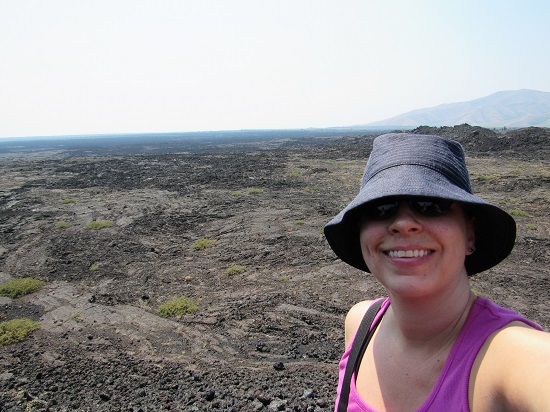Day 4, Thursday, July 27, 2017
This morning we got up, had breakfast, and piled in the van about 10 am.
Our first destination was the Hayden Valley, where it quickly became apparent that there wasn’t much wildlife to be spotted. The kids wanted to see bison and there were very few! We did stop for a bit to check out some distant wolves from Mollie’s Pack, who were hanging out in the same area where they were the previous summer, when I visited with my mom. They were beautiful!

A wolf from Mollie’s Pack (Susanna’s Photo)
We stopped at Dragon’s Mouth Spring and the Mud Volcano, and did a short boardwalk walk to look at the thermal features. The kids, as expected, were not impressed by the stinky, sulfur smelling thermals. I have to admit, of all the geysers, mud-pots and other thermal features, these aren’t the most exciting. But who could miss something called a Mud Volcano, or Dragon’s Mouth Spring?

Dragon’s Mouth Spring

The Mud Volcano – Yep, it’s muddy
We headed next to the Visitor’s Center at Fishing Bridge, and I got my passport stamps – and we found out there was a Ranger Talk later for the kids on river otters. Next up Pelican Valley and a short hike – where it promptly starting pouring rain – with thunder and lightning! Lightning in these areas makes me nervous, but the kids were whining because it was pouring and my brother made us all stop so we could “enjoy the experience.” Sorry bro, I gotta say, I am with the kids on this one! I was glad when we got back to the car after our one mile hike – we were soaked!

Pelican Valley before the rain

A dragonfly

These pelicans and cormorants were not excited
We had originally packed a picnic lunch, but we ended up eating in the van because of the rain. You win some, you lose some!
We tried to find another hike called Storm Point (ironic given the day), at Indian Pond, but we weren’t successful, and there was more thunder and lightning so we decided to scrap that idea and try to get out of the immediate path of the storm. We headed out towards the East Entrance and found our first close up bison. The kids loved it, so we all piled out of the car to take a look.

Our first look at a bison up close!
We also checked out a viewpoint that gave a fantastic view of Lake Yellowstone, as well as the damage caused by the the fires several years ago. Of course, as we were up there, we heard the thunder start to roll in. The weather changes so quickly! Seemed like a good time to get off the mountain – so we headed down to lower elevations.

The view of Yellowstone Lake
Next up we found the LeHardy Rapids. My mom and I had wanted to see it on our trip the year before, but it had been closed because there was a grizzly hanging out there! The rapids are seen from a gentle walk along the Yellowstone River, with boardwalks in many places. A man showed us where Cutthroat Trout hide in the calmer waters along the side of the river. They jump the rapids to get to their spawning sites.
Lake Trout were introduced to Lake Yellowstone, likely in the 1980s, and are decimating the Cutthroat Trout population. Lake Trout are bigger, swim deeper, and eat Cutthroat Trout. Unfortunately, animals like otters and osprey don’t prey on Lake Trout much because they are too deep in the water. It was a nice walk and the kids enjoyed looking for the fish.

The Yellowstone River and LeHardy Rapids

Me at the LeHardy Rapids

My brother and nephew checking out the Cutthroat Trout below

Great Blue Heron preening

Me again!
We went back to the Fishing Bridge Visitor’s Center to see the Ranger Talk on river otters. River otters weigh between 10 and 30 pounds, and eat primarily fish, but also young beavers and frogs. They have about 50 layers of fur to keep them insulated! They steal dens from beavers, and can hear fish in the water when they are on shore. What fantastically adapted animals!
There was another thunderstorm with hail when we were driving back to camp, so we went to the Canyon Visitor’s Center to wait it out. I watched the movie they have there and we learned a lot about the park.
We got a few groceries and went back to camp when the sun came back out – what a crazy day for weather! Dinner was a noodle box, with sausages, cucumber slices and canned corn. Not fancy but still delicious!
That evening, after dinner, several of us headed over to the Visitor’s Center nearby for a Ranger Talk with Ranger Cass Hennings on the history of Yellowstone, called “What’s in a Name?” She engaged us with tales of the first explorers, and how the various places in Yellowstone got their names. Places like Dunraven Pass, Sheepeater Cliff and even how the Yellowstone River came to be named Yellowstone! She told us the story of Truman Everts, who got lost for 37 days during an 1870 expedition, getting frostbite, scalding himself with hot thermal water and setting his hair of fire and starting a small forest fire. Oops… Ranger Hennings also shared information on the Native Americans and how they used the park too. It was really interesting! They normally do the evening Ranger talks outside in the amphitheater, but it was really cold and threatening to rain and thunderstorm – again!
After the talk, we head back to our pitch black campsite and headed to bed – it was very cold, but finally clear!
Distance for the Day: Driving within park
Canyon Campground, Yellowstone National Park: $30 per night for a tent site












































































































































